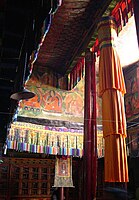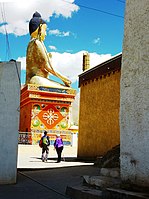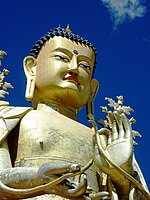Likir Monastery
| Likir Monastery | |
|---|---|
 | |
| Religion | |
| Affiliation | Tibetan Buddhism |
| Sect | Gelug |
| Location | |
| Location | Likir, Ladakh, India |
| Geographic coordinates | 34°16′36″N 77°12′54″E / 34.27667°N 77.21500°E |
| Architecture | |
| Founder | Duwang Chosje and Lhachen Gyalpo |
Likir Monastery or Likir Gompa (Klud-kyil) is a
Although Likir is relatively isolated, it was once on a major trade route from Tingmosgang via Hemis and Likir to Leh.[4]
History

Likir is mentioned in the
When Tibetologist August Hermann Francke visited the monastery in 1909 he was shown a long inscription written in black ink on a wall which outlined the history of the monastery. Francke had it copied and interprets it as follows:
"King Lha-chen-rgyal-po founded the monastery in the 11th century. In the 15th century, Lama Lha-dbang-chos-rje [a famous pupil of
Tsongkhapa converted the lamas to the reformed doctrines of the Ge-lug-pa order, and thus founded the monastery afresh as a Ge-lug-pa establishment. Then it is stated that seven generations after Lha-chen-rgyal-po, King Lha-chen-dngos-grub [c. 1290-1320] arose, and that he introduced the custom of sending all the novices to Lhasa. This statement is found in exactly the same words as we find in the rGyal-rabs"[8]
Eighteen generations later King bDe-legs-rnam-rgyal reigned, but his name has been erased from the inscription because he embraced Islam after the battle of Basgo in 1646–1647. The inscription itself is dated to the reign of King Thse-dbang-rnam-rgyal II (Tsewang Namgyal II, c. 1760–1780), who repaired the monastery after a conflagration.[5][9]
Below the monastery was a large
The monastery currently has approximately 120 Buddhist monks and a school with almost thirty students.

Historical notes on sign outside gompa:
Lu.Khyil (water spirits circled) popularly known as “Likil” Gonpa gives its name to Nagas (water spirits) who once lived there. It is another important Ge.lug.pa monastery in Ladakh. Lachen Gyalpo, the fifth king of Ladakh is said to have offered to Lama Duwans Chosje, a great master of meditation, the land for building a monastery in 1065. This monastery joined the Gelugpa order in the 15th century. The Du-Khang (Assembly Hall) contains Mar.ime.zat, Shakyamuni, and Maitreya (Buddhas of the past, present and future) an imposing statue of
arahats) The Gon.Khang houses the statue of Se.Ta.Pa an imposing protective deity of the monastery and Yamantaka. Likir Dos.mo.che, the annual festival of the monastery, is held from the 27th to the 29th of the 12th Tibetan month. By Courtesy of Tourism Dept. Leh
It is the seat of the
Layout and interior
-
View of Likir monastery
-
View of Likir gompa
-
Hanging prayer flags on the 23 m (75 ft) statue of Maitreya
-
Side view of Maitreya statue, Likir gompa
-
Closeup of Maitreya statue, Likir gompa
The monastery has two assembly halls, known as dukhangs. The older one is located on the right of the central courtyard, with six rows of seats for the lamas and a throne for the head lama of Likir.
Bookcases stand at the statue sides, with volumes of the Sumbum, describing the life and teachings of Tsong Khapa. The left wall has paintings of the 35 confessional Buddhas while the right wall has an image of Sakyamuni with two of his chiefs by his side.[7]
A ladder leads out of the hall, to the
Gallery
See also
Footnotes
- ^ Francke (1914), p. 88.
- ^ ISBN 81-7387-057-8.
- ^ a b c d "Likir Gompa". Buddhist-temples.com. Retrieved 6 October 2009.
- ^ Francke (1977), p. 91.
- ^ a b c Francke (1914), p. 87.
- ^ Rizvi (1994), p. 241.
- ^ a b c d e f g h "Likir monastery". Buddhist Tourism. Archived from the original on 12 July 2012. Retrieved 6 October 2009.
- ^ Francke (1914), pp. 24, 87.
- ^ Francke (1977), p. 130.
- ^ Rizvi (1996), pp. 242-242.
- ^ Banerjee (2010), p. 131.
- ^ "Likir Gompa Tibet". Culture Holidays. Retrieved 4 October 2009.
References
- Banerjee, Partha, S. (2010). Ladakh, Kashmir & Manali: The Essential Guide. 2nd Edition. Milestone Books, Calcutta. ISBN 978-81-903270-2-2.
- Francke, A. H. 1914, 1926. Antiquities of Indian Tibet. Vol. 1: Personal Narrative; Vol. 2: The Chronicles of Ladak and Minor Chronicles, texts and translations, with Notes and Maps. Reprint 1972. S. Chand & Co., New Delhi.
- Francke, A. H. (1977). A History of Ladakh. 1907 edition with critical introduction and annotations by S. S. Gergen & F. M. Hassnaian. Sterling Publishers, New Delhi.
- Rizvi, Janet. 1996. Ladakh: Crossroads of High Asia. Second Edition. Oxford India Paperbacks. 3rd Impression 2001. ISBN 0-19-564546-4.













